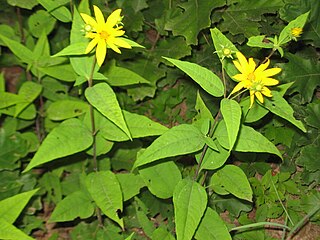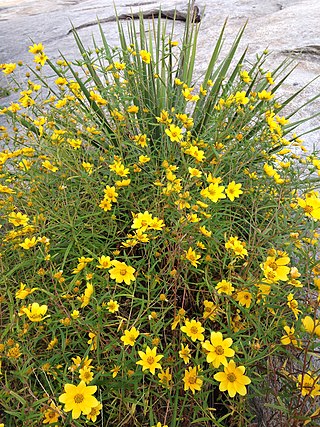
Helianthus is a genus comprising about 70 species of annual and perennial flowering plants in the daisy family Asteraceae commonly known as sunflowers. Except for three South American species, the species of Helianthus are native to North America and Central America. The best-known species is the common sunflower. This and other species, notably Jerusalem artichoke, are cultivated in temperate regions and some tropical regions, as food crops for humans, cattle, and poultry, and as ornamental plants. The species H. annuus typically grows during the summer and into early fall, with the peak growth season being mid-summer.

Helianthus nuttallii, or Nuttall's sunflower, is a species of sunflower native to northern, central, and western North America, from Newfoundland west to British Columbia, south to Missouri, New Mexico, and California.

Helianthus pauciflorus, called the stiff sunflower, is a North American plant species in the family Asteraceae. It is widespread across the Great Plains, the Rocky Mountains, and the Great Lakes region, and naturalized in scattered locations in the eastern United States and in much of southern Canada.

Anaphalis margaritacea, commonly known as the western pearly everlasting or pearly everlasting, is an Asian and North American species of flowering perennial plant in the family Asteraceae.

Helianthus giganteus, the giant sunflower or tall sunflower, is a species of Helianthus native to the eastern United States and eastern and central Canada, from Newfoundland west to Alberta south to Minnesota, Mississippi, and South Carolina.

Gaillardia aristata is a North American species of flowering plant in the sunflower family, known by the common names common blanketflower and common gaillardia. This perennial wildflower is widespread across much of North America, from Yukon east to Québec and south as far as California, Arizona, Illinois, and Connecticut, although it may be naturalized rather than native in parts of that range. It is also naturalized in scattered locations in Europe, Australia, and South America.

Helianthus cusickii is a species of sunflower known by the common names Cusick's sunflower and turniproot sunflower. It is native to the western United States from Washington, Oregon, Idaho, northern California, and northwestern Nevada.

Helianthus maximiliani is a North American species of sunflower known by the common name Maximilian sunflower.

Helianthus divaricatus, commonly known as the rough sunflower, woodland sunflower, or rough woodland sunflower, is a North American species perennial herb in the family Asteraceae. It is native to central and eastern North America, from Ontario and Quebec in the north, south to Florida and Louisiana and west to Oklahoma and Iowa.

Ribes aureum, known by the common names golden currant, clove currant, pruterberry and buffalo currant, is a species of flowering plant in the genus Ribes native to North America.

Balsamorhiza sagittata is a North American species of flowering plant in the tribe Heliantheae of the family Asteraceae known by the common name Arrowleaf Balsamroot. It is widespread across western Canada and much of the western United States.

Helianthus occidentalis, the fewleaf sunflower or western sunflower, is a species of sunflower native to the Eastern and Central United States. It grows mostly in the Great Lakes Region and in the Ozarks, with additional populations scattered as far as Massachusetts, Texas, and the Florida Panhandle.

Helianthus petiolaris is a North American plant species in the family Asteraceae, commonly known as the prairie sunflower or lesser sunflower. Naturalist and botanist Thomas Nuttall was the first to describe the prairie sunflower in 1821. The word petiolaris in Latin means, “having a petiole”. The species originated in Western United States, but has since expanded east. The prairie sunflower is sometimes considered a weed.

Helianthus angustifolius is a species of sunflower known by the common name narrowleaf sunflower or swamp sunflower. It is native to the south-central and eastern United States, found in all the coastal states from Texas to Long Island, and inland as far as Missouri. It is typically found in the coastal plain habitat, particularly in wet areas.

Helianthus decapetalus, known by the common names thinleaf sunflower and thin-leaved sunflower, is a perennial forb in the family Asteraceae. It is native to the Eastern and Central United States and Canada, from New Brunswick west to Iowa, Wisconsin, and Ontario, south as far as Georgia and Louisiana. It produces yellow composite flowers in late summer or early fall.

Helianthus hirsutus is a North American species of sunflower known by the common name hairy sunflower. It is widespread across south-central Canada, the eastern and central United States, and northeastern Mexico. It ranges from Ontario south to Florida, Coahuila, and Nuevo León, and west as far as Minnesota, Nebraska, and Texas.

Helianthus mollis is a species of sunflower known by the common names ashy sunflower, hairy sunflower or downy sunflower. It is widespread across much of the United States and Canada, primarily the Great Lakes region from Ontario south to Texas and Alabama. Additional populations are found in the states of the Atlantic Coast from Maine to Georgia, but these appear to be introduced.

Helianthus porteri is a species of sunflower known by the common names Porter's sunflower, Stone Mountain daisy and Confederate daisy. The term "daisy" is a imprecise because the species is a sunflower (Helianthus) rather than a daisy. Likewise, although the plant grows on Stone Mountain, GA, its range extends well beyond. The connection to the Confederacy is through Stone Mountain which contains a confederate monument, although the connection is tenuous as the species was named before the Civil War in 1849 by Harvard botanist Asa Gray in honor of Thomas Conrad Porter, a Pennsylvanian minister and botanist who collected the plant in Georgia. Gray initially named the plant Rudbeckia porteri, changed to Helianthus in 1998 by John F. Pruski. The common name Porter's sunflower therefore most closely accords with the history of botanical discovery and naming.

Helianthus salicifolius is a North American species of sunflower known by the common name willowleaf sunflower. It is native to the central United States, primarily in the Great Plains and Ozark Plateau. There are a few reports of scattered populations in the Northeast and Midwest parts of the country, but these appear to be escapes from cultivation.

Helianthus silphioides is a North American species of sunflower known by the common names rosinweed sunflower or Ozark sunflower. It is native to the central United States, primarily in the Ozarks and the Tennessee Valley with additional populations north into Kentucky and Illinois and south as far as Louisiana, Mississippi and Alabama.





















